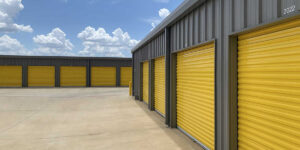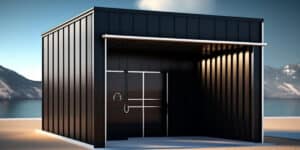From Storage to Sanctuary: Transforming Your Garage with a Shipping Container Floor Plan
Are you tired of your garage being nothing more than a cluttered storage space? Do you long for a sanctuary where you can unwind and pursue your hobbies? Look no further than a shipping container floor plan. Yes, you read that right! Shipping containers are not just for transporting goods anymore. They can be transformed into stylish and functional living spaces, including the perfect garage conversion.
The Appeal of Shipping Container Transformations
Shipping containers have gained popularity in recent years for their versatility and sustainability. These steel structures are designed to withstand the harshest weather conditions and can be easily modified to fit various purposes. With their modular nature, shipping containers provide a blank canvas for creative homeowners looking to repurpose and transform their space.
The Advantages of Converting Your Garage into a Shipping Container
Converting your garage into a shipping container sanctuary offers several advantages over traditional renovations. Here are a few reasons why you should consider this innovative approach:
Cost-effectiveness
Garage conversions can often be costly and time-consuming. However, using a shipping container as the basis for your transformation can significantly reduce both the time and money spent on construction. Shipping containers are readily available and can be purchased at a fraction of the cost of traditional building materials.
Sustainability
By repurposing a shipping container, you are contributing to the promotion of sustainable living. These containers are recycled structures that would otherwise go to waste. By transforming one into your garage, you are reducing the demand for new construction materials and minimizing your carbon footprint.
Flexibility
One of the greatest advantages of shipping container conversions is their flexibility. Whether you want to create a workshop, art studio, gym, or even a guest house, the design possibilities are virtually endless. With a well-thought-out floor plan, your garage can be transformed into a personalized sanctuary that meets your specific needs.
Designing Your Shipping Container Garage Floor Plan
Creating a functional and aesthetically pleasing shipping container garage requires careful planning and consideration. Here are some key factors to keep in mind when designing your floor plan:
Space Optimization
Shipping containers come in various sizes, typically ranging from 20 to 40 feet in length. You will need to assess the available space in your garage to determine the appropriate container size. Consider your desired activities and storage needs to optimize the use of the available square footage.
Natural Light and Ventilation
Ensure that your shipping container garage has ample natural light and ventilation. Incorporate windows and skylights into your floor plan to create a bright and airy atmosphere. Good airflow will also help regulate temperature and prevent moisture buildup.
Insulation and Climate Control
Shipping containers are made of steel, which can become extremely hot or cold depending on the weather. Proper insulation is crucial to maintain a comfortable living environment. Consider using spray foam insulation or insulated panels to regulate the temperature inside your garage.
Interior Design and Functionality
The interior design of your shipping container garage should reflect your personal style and cater to your specific needs. Consider the layout of your space, storage solutions, and the placement of furniture and equipment. Utilize vertical space effectively to maximize storage options.
Transform Your Garage, Transform Your Life
Converting your garage into a shipping container sanctuary offers a unique opportunity to create a personalized space that truly reflects your lifestyle. With careful planning and a well-executed floor plan, you can transform your garage from a cluttered storage space into a functional and stylish sanctuary. Embrace the versatility and sustainability of shipping containers and unlock the potential of your garage!
Unlocking the Potential: Creative Ideas for Shipping Container Garage Floor Plans
When it comes to building a garage, traditional options may seem a bit mundane. But have you ever considered the versatility and unique charm of shipping container garage floor plans? These repurposed containers offer endless possibilities for creating a one-of-a-kind space that not only protects your vehicles but also enhances the overall aesthetic appeal of your property. In this blog post, we will explore some creative ideas for shipping container garage floor plans that will surely unlock the potential of this unconventional building material.
1. Multi-level Garage
One way to maximize the use of space in your shipping container garage is by incorporating multiple levels. By stacking containers vertically, you can create a multi-level garage that provides ample storage space for your vehicles, tools, and equipment. The ground level can serve as the main parking area, while the upper levels can be utilized for additional storage or even transformed into a workshop or hobby space.
2. Green Roof Garage
If you’re looking to incorporate sustainability into your garage design, consider adding a green roof to your shipping container garage. Green roofs not only provide insulation and reduce energy consumption but also create a visually appealing and eco-friendly space. By installing a layer of soil and planting vegetation on top of your container, you can transform your garage into a beautiful green oasis that blends into the surrounding landscape.
3. Garage with Living Space
Why limit the functionality of your shipping container garage to just vehicle storage? With some thoughtful planning and creative design, you can transform your garage into a versatile space that serves dual purposes. By adding insulation, plumbing, and electrical systems, you can convert a section of your garage into a comfortable living space or even a fully-equipped guesthouse. This innovative approach not only saves space but also adds value to your property.
4. Garage with Rooftop Deck
Who says garages can’t be a place to relax and unwind? By utilizing the roof of your shipping container garage, you can create a rooftop deck that offers breathtaking views and a perfect spot for outdoor entertaining. Install a staircase or a ladder for easy access and consider adding a pergola, seating area, and even a small garden to create a tranquil oasis above your vehicles.
5. Garage with Studio Space
If you’re an artist, musician, or simply someone who enjoys creative activities, why not incorporate a studio space into your shipping container garage? By partitioning a section of the container and equipping it with proper lighting, ventilation, and soundproofing, you can have a dedicated area to pursue your passions. This setup allows you to have a private and inspiring space conveniently located just steps away from your home.
6. Garage with Extra Storage
Storage is always a valuable commodity, and a shipping container garage can provide the perfect solution. By utilizing the vertical space within the container, you can install shelves, hooks, and other storage systems to keep your belongings organized and easily accessible. From bikes and sports equipment to gardening tools and seasonal decorations, your shipping container garage can become a haven for all your storage needs.
Conclusion
Shipping container garage floor plans offer a world of possibilities for those seeking a unique and functional space to house their vehicles and more. With a little creativity and planning, you can turn a simple shipping container into a garage that goes beyond its primary purpose. Whether you choose to create a multi-level garage, a green roof oasis, or incorporate additional living or studio space, the potential for customization is endless. So why settle for a traditional garage when you can unlock the potential of shipping container garage floor plans?
Step-by-Step: How to Create a Functional and Stylish Shipping Container Garage Floor Plan
If you’re considering building a garage using shipping containers, you’re not alone. Shipping container garages have become increasingly popular due to their affordability, versatility, and sustainability. However, before you start construction, it’s crucial to create a well-thought-out floor plan that ensures functionality and style. In this step-by-step guide, we will walk you through the process of creating a functional and stylish shipping container garage floor plan.
Step 1: Assess Your Needs and Space
The first step in designing your shipping container garage floor plan is to assess your needs and the available space. Consider how many vehicles you need to accommodate, whether you require additional storage space, and if you plan to include a workshop or other amenities. Measure the dimensions of the area where you plan to build the garage so that you can accurately plan the layout.
Step 2: Determine the Container Layout
Next, determine the layout of the shipping containers. Depending on the available space and your needs, you can either use a single container or multiple containers stacked or arranged side by side. Consider the orientation of the containers to maximize natural light and ventilation. Take into account the entry and exit points, as well as the location of windows and doors.
Step 3: Plan the Interior Space
Once you have decided on the container layout, it’s time to plan the interior space. Divide the garage into zones based on functionality. Allocate space for parking vehicles, storage, and any additional amenities. Consider the height of the containers and plan for sufficient overhead clearance for your vehicles. If you plan to incorporate a workshop, make sure you have ample space for workbenches, tools, and storage of materials.
Step 4: Design the Flooring
Choosing the right flooring for your shipping container garage is essential for both functionality and style. Concrete is a popular choice due to its durability and affordability. Make sure the flooring is properly insulated and sealed to prevent moisture and damage. If you want to add a touch of style, consider options like epoxy coatings, rubber mats, or interlocking tiles that not only enhance the aesthetics but also provide extra protection to the floor.
Step 5: Plan for Lighting and Electrical
A well-lit garage is crucial for safety and convenience. Plan for sufficient lighting throughout the space, including overhead lights, task lights for specific work areas, and exterior lighting for the entry points. Additionally, consider your electrical needs for power tools, charging stations, and other equipment. Consult with a licensed electrician to ensure your electrical system is properly designed and installed.
Step 6: Consider Ventilation and Climate Control
Proper ventilation is essential to prevent condensation and maintain air quality within the garage. Consider installing windows or vents strategically to promote air circulation. If you live in an area with extreme temperatures, you may also want to consider insulation and climate control options such as HVAC systems or fans.
Step 7: Incorporate Security Measures
Protecting your vehicles and belongings is crucial, so consider incorporating security measures into your shipping container garage design. Install sturdy locks on entry doors and windows. Consider adding security cameras or an alarm system to deter potential theft. If the garage connects to your home, ensure there are secure access points between the two structures.
Step 8: Add Personal Touches
Finally, don’t forget to add personal touches to make your shipping container garage feel like a welcoming and stylish space. Consider painting the walls in your preferred color scheme or adding decals or murals to reflect your personality. Incorporate storage solutions that are both functional and aesthetically pleasing, such as shelving units or customized cabinets.
By following these step-by-step guidelines, you can create a functional and stylish shipping container garage floor plan that meets your needs and exceeds your expectations. Remember to consult with professionals when necessary, such as architects, contractors, and electricians, to ensure your design is structurally sound and meets all building codes. Happy planning and building!
Revolutionize Your Garage: Innovative Shipping Container Floor Plans
Are you tired of your cluttered and disorganized garage? Do you dream of transforming it into a functional and stylish space? Look no further than shipping container floor plans! These innovative designs will revolutionize your garage, turning it into a modern and versatile area that meets all your needs.
The Advantages of Shipping Container Floor Plans
Shipping containers have gained immense popularity in recent years due to their durability, versatility, and cost-effectiveness. When it comes to garage transformations, using shipping containers as the building blocks offers several advantages:
1. Quick and Easy Installation
One of the biggest advantages of using shipping containers for your garage transformation is their quick and easy installation process. These containers are pre-built and designed to be transported, making them incredibly simple to set up. With a few modifications, you can have your new garage up and running in no time.
2. Cost-Effective Solution
Compared to traditional construction methods, shipping container floor plans provide a cost-effective solution for transforming your garage. The containers themselves are affordable, and their modular nature allows for easy expansion or downsizing as needed. Additionally, using shipping containers eliminates the need for extensive foundation work, further reducing costs.
3. Sustainable and Eco-Friendly
If you’re conscious about the environment, using shipping containers for your garage transformation is a sustainable and eco-friendly choice. By repurposing these containers, you’re giving them a second life and reducing waste. Furthermore, shipping containers can be outfitted with eco-friendly features such as solar panels and rainwater harvesting systems, making your garage more energy-efficient.
Innovative Shipping Container Floor Plans
Now that you’re aware of the advantages, let’s explore some innovative shipping container floor plans that will transform your garage into a space you’ll love:
1. Home Office or Studio
With more people working remotely or pursuing creative endeavors, having a dedicated home office or studio space is essential. Shipping containers can be easily converted into a comfortable and inspiring workspace. Install large windows for natural light, insulate the container for soundproofing, and add shelving and storage solutions to keep your workspace organized and clutter-free.
2. Gym or Fitness Center
Why spend money on a gym membership when you can have your own fitness center right in your garage? Convert a shipping container into a gym by installing rubber flooring, mirrors, and workout equipment. Customize the layout to include a cardio area, weightlifting section, and a small corner for stretching. You’ll have all the convenience of a gym without the monthly fees!
3. Guest House or Airbnb Rental
If you frequently have guests or are looking for an additional income stream, transform your garage into a cozy guest house or Airbnb rental. Shipping containers can be transformed into comfortable living spaces complete with a bedroom, bathroom, and kitchenette. Add some stylish furnishings and amenities to create a welcoming and inviting environment for your guests.
4. Workshop or Creative Space
For those with a passion for DIY projects or artistic endeavors, a workshop or creative space is a must-have. Convert a shipping container into the ultimate workshop by installing a workbench, storage cabinets, and ample lighting. Customize the space to fit your specific needs, whether it’s woodworking, painting, or crafting.
5. Entertainment Area or Game Room
If you love entertaining friends and family, consider transforming your garage into an entertainment area or game room. Install a bar, comfortable seating, and a large TV for a sports viewing area. Add a pool table, foosball table, or arcade games for endless fun. With a shipping container floor plan, you can create a versatile space that easily adapts to different types of gatherings.
Conclusion
Don’t let your garage remain a cluttered and underutilized space. Revolutionize it with innovative shipping container floor plans. Enjoy the advantages of quick installation, cost-effectiveness, and sustainability, while transforming your garage into a functional and stylish area that meets your specific needs. Whether you choose a home office, gym, guest house, workshop, or entertainment area, shipping container floor plans offer endless possibilities for creating the garage of your dreams.
The Ultimate Guide to Designing Your Shipping Container Garage Floor Plan
When it comes to building a garage, many people are now turning to shipping containers as a cost-effective and sustainable alternative. Not only do shipping containers provide a sturdy and secure structure, but they also offer flexibility in terms of design and layout. One crucial aspect of designing your shipping container garage is creating an efficient floor plan. In this guide, we will walk you through the key considerations and steps to help you create the ultimate shipping container garage floor plan.
1. Assess Your Needs
Before diving into the design process, it’s important to assess your needs and determine how you plan to use your garage. Are you looking to store vehicles, create a workshop, or use it as additional living space? Understanding your requirements will help you make informed decisions throughout the design process.
2. Measure and Analyze the Space
The next step is to measure the available space where your shipping container garage will be located. Take accurate measurements of the length, width, and height, as well as any existing structures or obstacles that may impact the placement or design. Analyzing the space will allow you to work within the limitations and optimize the layout accordingly.
3. Decide on the Number of Containers
Depending on your needs and available space, you’ll need to determine the number of shipping containers required for your garage. One container may suffice for a single vehicle storage, but if you’re looking for additional space or multiple vehicles, you may need more than one container. Consider the dimensions of the containers and how they will fit into your floor plan.
4. Plan the Layout
Once you know how many containers you’ll be using, it’s time to plan the layout of your shipping container garage. Start by identifying the primary entrance and exit points, as well as any additional doors or windows you may require. Consider the flow of movement within the space and ensure easy access to all areas. If you’re planning a workshop, allocate a specific area for workbenches and tools.
5. Consider Storage and Organization
Efficient storage and organization are crucial for any garage. Think about the types of items you’ll be storing and plan for adequate shelving or cabinets. Utilize the vertical space by installing overhead storage or hanging racks. Additionally, consider incorporating a designated area for tools, cleaning supplies, and other frequently used items.
6. Plan for Lighting and Ventilation
Proper lighting and ventilation are essential for a functional and comfortable garage. Take advantage of natural light by placing windows strategically. Incorporate artificial lighting fixtures, such as overhead lights or task lighting, to ensure adequate brightness. Additionally, plan for ventilation options to prevent moisture buildup and promote air circulation within the space.
7. Consider Electrical and Plumbing Needs
If you plan to use your shipping container garage as a workshop or living space, you’ll need to consider electrical and plumbing requirements. Plan for sufficient electrical outlets, including dedicated circuits for power tools or appliances. If plumbing is necessary, allocate space for a sink or bathroom facilities, ensuring proper access to water and drainage systems.
8. Insulation and Climate Control
Shipping containers are typically made of steel, which can make them susceptible to temperature fluctuations. To create a comfortable environment, consider insulation options to regulate the temperature inside your garage. Insulation will help keep the space warm in the winter and cool in the summer. Depending on your climate, you may also want to explore options for heating or air conditioning.
9. Seek Professional Assistance if Needed
Designing a shipping container garage floor plan can be a complex task, especially if you have specific requirements or limited experience in construction and design. If you’re unsure about any aspect of the process, it’s recommended to seek professional assistance. Architects, engineers, or specialized container conversion companies can provide valuable expertise and ensure your design meets safety regulations and building codes.
10. Revise and Refine
Once you’ve created your initial floor plan, take the time to revise and refine it. Consider different layouts, explore alternative options, and make adjustments based on feedback from professionals or family members. Remember that the design process is iterative, and it’s essential to fine-tune your floor plan until you’re satisfied with the final result.
Designing your shipping container garage floor plan requires careful planning and consideration of various factors. By assessing your needs, analyzing the space, planning the layout, and incorporating key elements such as storage, lighting, and insulation, you can create a functional and efficient garage that meets your requirements. Whether you’re using it for vehicle storage, a workshop, or additional living space, a well-designed shipping container garage can be a valuable addition to your property.




